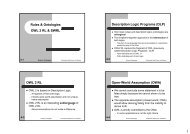A Review of Multi-Label Classification Methods - LPIS
A Review of Multi-Label Classification Methods - LPIS
A Review of Multi-Label Classification Methods - LPIS
You also want an ePaper? Increase the reach of your titles
YUMPU automatically turns print PDFs into web optimized ePapers that Google loves.
The third problem transformation method that we will mention (dubbed PT3), considers each differentset <strong>of</strong> labels that exist in the multi-label data set as a single label. It so learns one single-labelclassifier H: X → P(L) , where P(L) is the power set <strong>of</strong> L. Table 4 shows the result <strong>of</strong> transforming thedata set <strong>of</strong> Table 1 using this method. One <strong>of</strong> the negative aspects <strong>of</strong> PT3 is that it may lead to datasets with a large number <strong>of</strong> classes and few examples per class. PT3 has been used in the past in(Boutell et al., 2004; Diplaris et al., 2005).Table 4: Transformed data set using PT3Ex. Sports (Sports ∧ Politics) (Science ∧ Politics) (Science ∧ Religion)1 X2 X3 X4 XThe most common problem transformation method (dubbed PT4) learns |L| binary classifiers H l : X →{l, ¬l} , one for each different label l in L. It transforms the original data set into |L| data sets D l thatcontain all examples <strong>of</strong> the original data set, labelled as l if the labels <strong>of</strong> the original examplecontained l and as ¬l otherwise. It is the same solution used in order to deal with a single-label multiclassproblem using a binary classifier.For the classification <strong>of</strong> a new instance x this method outputs as a set <strong>of</strong> labels the union <strong>of</strong> the labelsthat are output by the |L| classifiers:H( x) = { l}:H ( x) l=PT 4Ull∈LFigure 1 shows the four data sets that are constructed by PT4 when applied to the data set <strong>of</strong> Table 1.PT4 has been used in the past in (Boutell et al., 2004; Goncalves & Quaresma, 2003; Lauser & Hotho,2003; Li & Ogihara, 2003).








